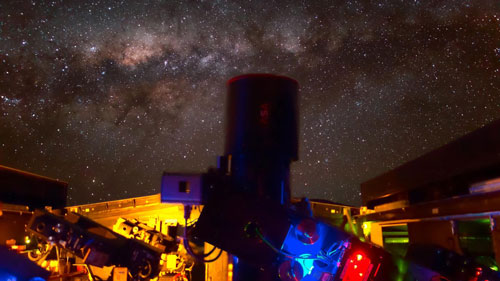| Jan 15, 2015 |
New telescopes to search for planets outside the Solar System
|
|
(Nanowerk News) The Next-Generation Transit Survey (NGTS) telescope at the Paranal Observatory, operated by the European Southern Observatory (ESO) in the Atacama Desert in northern Chile, has achieved 'first light'. The German Aerospace Center (Deutsches Zentrum für Luft- und Raumfahrt; DLR) has provided eight of the 12 cameras in the telescope facility. They will be looking for extrasolar planets roughly the size of the planet Neptune.
|
 |
| View of the Milky Way.
|
|
Sensitive cameras record exoplanet transits
|
|
Because of their distance from Earth, extrasolar planets cannot be imaged directly, so special telescopes are necessary. These cameras are highly sensitive; they are capable of receiving extremely weak light signals and detecting differences in their strength. This can be used to observe transits of exoplanets, where planets dim the light from their parent star as they pass in front of it. "To date, ground-based observation programmes have not been able to detect such small transit signals with this level of precision," says Heike Rauer, head of the Extrasolar Planets and Atmospheres department at the DLR Institute of Planetary Research. "This will now be possible for the first time using the new telescopes," adds Rauer.
|
|
NGTS observes a much wider area of the sky than NASA's Kepler telescope: "With such a large search field, we are primarily aiming to discover smaller exoplanets that, nevertheless, produce a comparatively large difference in brightness and as such are particularly well suited to conducting detailed investigations into, for example, their mass and atmosphere," explains Rauer. The planets they are looking for are comparable in size to Neptune, which has a diameter almost four times that of Earth. The search will cover planets with diameters in the range of between two and eight times that of Earth.
|
|
The Atacama desert – a perfect location to search for exoplanets
|
|
The choice of location is of great significance. The Atacama Desert in northern Chile offers the best conditions – the frequent clear nights and extremely dry air at an altitude of 4000 metres above sea level provide the scientists with optimal measurement results.
|
|
The planetary researchers supervised the construction of the first telescope on site and will also be supporting the installation of the remaining telescopes. The complete facility will begin operations during 2015.
|
|
DLR developed the required automated analysis software in tandem with its NGTS partners. The Berlin-based planetary researchers already have years of experience in the area of high-precision astronomical photometry. With the CoRoT mission, the scientists have already discovered 28 exoplanets since 2012.
|
|
Next-Generation Transit Survey
|
|
The Next-Generation Transit Survey (NGTS) is a wide-field observing system made up of an array of 12 telescopes, each with an aperture of 20 centimetres. This new facility, being built by a UK, Swiss and German consortium, is located at ESO's Paranal Observatory in northern Chile and benefits from outstanding observing conditions as well as the excellent support facilities available at this site.
|
|
NGTS is designed to autonomously search for exoplanetary transits by continuously monitoring the brightness of several hundreds of thousands of comparatively bright stars in the southern sky. In doing so, it will reach a level of accuracy in measuring the brightness of stars – one part in a thousand – never before attained with a ground-based wide-field survey instrument.
|
|
Achieving such a high level of precision with brightness measurements across a large field of view is technically very challenging. The key technologies for NGTS have already been demonstrated using a smaller prototype that was operated on La Palma (Canary Islands) in 2009 and 2010. NGTS is also building on the success of the SuperWASP experiment, which has played a major role in the detection of large gas planets.
|
|
From first light measurements to determining the mass, density and atmospheric composition
|
|
The planets discovered with NGTS will be investigated in more detail using larger telescopes, including ESO's Very Large Telescope (VLT). One important goal of the project is to find planets that produce a large enough brightness variation to enable the mass of the planet to be accurately determined. This, in turn, will allow the density of the planet to be measured and clues about its composition to be derived. With some of these planets, it might also then be possible to conduct more detailed investigations of their atmospheres. As a planet passes in front of its parent star, the starlight passes through the atmosphere around the edge of the planetary disk; this leaves tiny but detectable signatures in the light. To date, it has only been possible to conduct such measurements with very few planets. NGTS is expected to discover many more such candidates.
|
|
NGTS is the first telescope project not operated by ESO to be based at the Paranal Observatory; several similar projects are running at the older La Silla Observatory. The NGTS data will be stored in the ESO archive and made available to astronomers worldwide.
|
|
The NGTS consortium is comprised of the University of Warwick, Queen's University Belfast, the University of Leicester, the University of Cambridge (all in the United Kingdom), the University of Geneva (Switzerland) and the German Aerospace Center (Deutsches Zentrum für Luft- und Raumfahrt; DLR) in Berlin.
|

